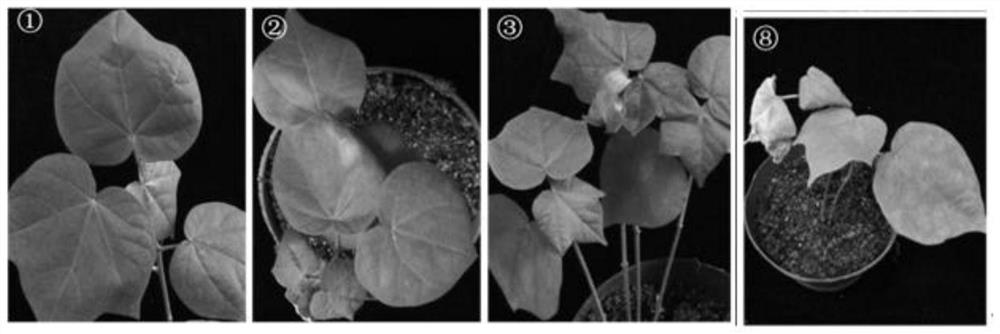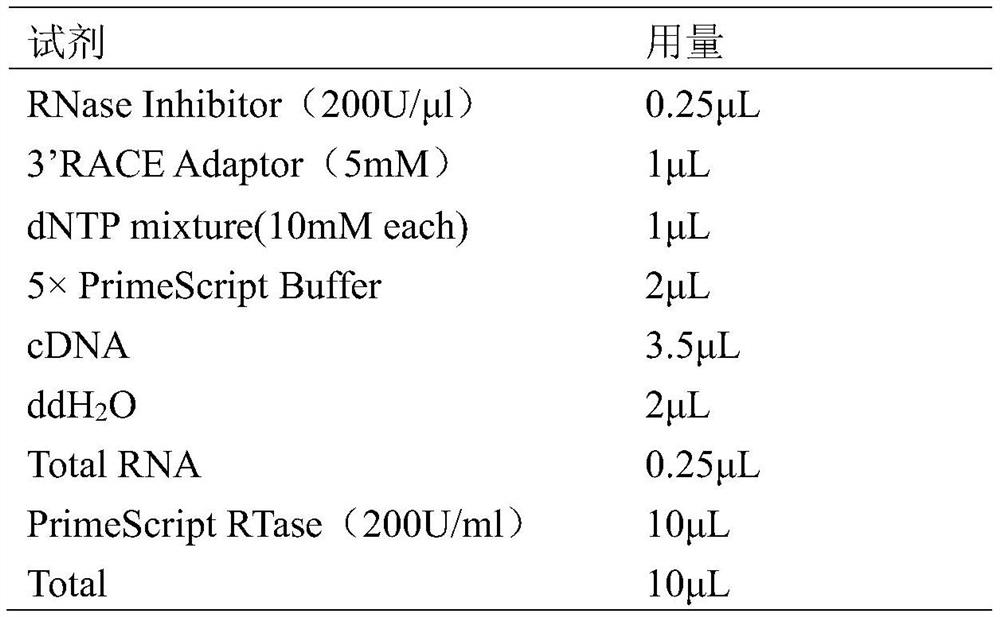Upland cotton ghebf1 gene, protein and application
An upland cotton, gene technology, applied in the field of molecular biology, can solve the problem that there is no EBF homologous gene research report and so on
- Summary
- Abstract
- Description
- Claims
- Application Information
AI Technical Summary
Problems solved by technology
Method used
Image
Examples
Embodiment 1
[0033] Cloning of Example 1 Upland Cotton GhEBF1 Gene
[0034] 1. Extraction of RNA
[0035] RNAprep Pure plant polyphenol polysaccharide total RNA extraction kit was used to extract RNA from cotton KV3 leaf samples in cotton varieties.
[0036] 2. Synthesis of cDNA
[0037] 2.1 Synthesis of intermediate fragment cDNA
[0038] The cDNA of the intermediate fragment was synthesized using the FastQuant cDNA First Strand Synthesis Kit to reverse transcribe the cDNA.
[0039] 2.2 Synthesis of cDNA at the 3' end
[0040] The synthesis system of cDNA at the 3' end is as follows:
[0041] Table 1
[0042]
[0043] Mix according to the above system, after centrifugation, place on PCR instrument at 42°C for 60 minutes, and at 70°C for 15 minutes, cool on ice after the reaction, and store at -20°C.
[0044] 3.3 Synthesis of cDNA at the 5' end
[0045] The cDNA synthesis system of 5'RACE is as follows:
[0046] first step:
[0047] Table 2
[0048]
[0049] Mix well, centrif...
Embodiment 2
[0116] Example 2 Effect of Silencing Verticillium Wilt-resistant Upland Cotton Variety KV3 on Verticillium Wilt Disease Resistance under the Stress of Verticillium dahliae
[0117] (1) Material
[0118] The wild-type Verticillium wilt-resistant upland cotton variety Zhiqian KV3 and the Verticillium wilt-resistant upland cotton variety Zhiqian KV3 with GhEBF1 gene silenced were used as experimental materials.
[0119] (2) Experimental grouping
[0120] Control group: Zhongzhi Cotton KV3 (provided by the Institute of Plant Protection, Chinese Academy of Agricultural Sciences);
[0121] Experimental group: GhEBF1 gene-silenced GhEBF1-resistant upland cotton planting KV3, transforming empty vector (CLCrV-00) planting cotton KV3 (refer to Zhang Huachong's master's thesis "VIGS technology analysis of genes related to Verticillium wilt resistance in upland cotton Preliminary identification of GHB2 function", Graduate School of Chinese Academy of Agricultural Sciences, 2016; and Ren...
Embodiment 3
[0131] Example 3 Verticillium dahliae stress transfection overexpression GhEBF1 Arabidopsis Verticillium dahlia resistance detection
[0132] (1) Material
[0133] The second-generation Arabidopsis thaliana and wild-type Arabidopsis transfected with the GhEBF1 gene were used as experimental materials (see Zhang Huachong's master's thesis "Preliminary identification of the function of GHB2, a gene related to resistance to Verticillium wilt in upland cotton by VIGS technology", China Graduate School of the Chinese Academy of Agricultural Sciences, 2016; and Ren Yuhong's master's thesis "Cotton Verticillium wilt control technology and the research on the function of two resistance-related genes", Graduate School of the Chinese Academy of Agricultural Sciences, 2018).
[0134] (2) Cultivation substrate
[0135] Medium: 1 / 2MS medium; 1 / 2MS+50mg / L Kanamycin medium;
[0136] Cultivation substrate: vermiculite + 1 / 4MS nutrient solution
[0137] (3) Experimental Design and Determina...
PUM
 Login to View More
Login to View More Abstract
Description
Claims
Application Information
 Login to View More
Login to View More - R&D
- Intellectual Property
- Life Sciences
- Materials
- Tech Scout
- Unparalleled Data Quality
- Higher Quality Content
- 60% Fewer Hallucinations
Browse by: Latest US Patents, China's latest patents, Technical Efficacy Thesaurus, Application Domain, Technology Topic, Popular Technical Reports.
© 2025 PatSnap. All rights reserved.Legal|Privacy policy|Modern Slavery Act Transparency Statement|Sitemap|About US| Contact US: help@patsnap.com



